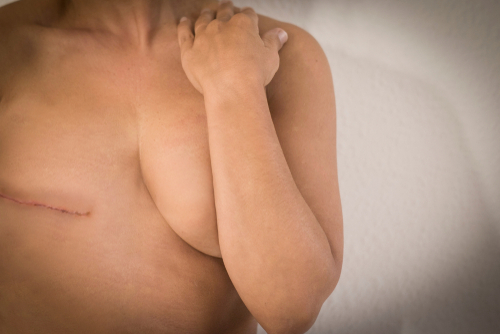What is Breast Reconstruction Surgery?
Breast reconstruction is a highly individualized procedure. No female body is the same, and the situation surrounding your cancer and medical treatment will also be unique to you. However, cancer patients often ask many of the same questions about reconstruction. Breast reconstruction surgery is a part of breast cancer treatment where a woman may have her breasts rebuilt to return them to a natural shape and size. The look may also help a woman even out the look of her breasts after cancer removal.
Breast reconstruction with implants is the most common procedure performed because it provides instant results. However, there are risks associated with having this type of surgery, such as infection, pain around the breast area during the healing process, asymmetry in size between breasts if only one breast has been reconstructed, and/or implant leakage or rupture, which may require revisional surgery. Breast Reconstruction with tissue removal has no risk of implant complications, but it takes longer for recovery when compared to breast reconstruction with implants.
In general, patients who undergo breast reconstructive surgeries have high rates of satisfaction with the results.
Breast reconstruction uses a breast implant or tissue from another area of your body to recreate the shape and feel of a breast. It’s often referred to as breast reconstruction, breast restoration, breast augmentation, breast implant surgery, nipple and areola repigmentation, and mastectomy tattooing.
Learn more about whether breast reconstruction is a good fit for your life by considering the following frequently asked questions.
Breast Reconstruction FAQ’s:
How long does breast reconstruction surgery take to complete?
Breast reconstructive surgeries can take up to 7 hours if both breasts are reconstructed, breast tissue is removed, and breast implants are put in place. If only one breast needs reconstruction it can be done under 3 hours. Depending on the breast surgery, a breast lift may be necessary at a later date.
Will breast reconstruction surgery affect breast cancer treatment?
If you are going through breast cancer treatment it is important to know that breast reconstruction surgery does not always affect your ability to receive chemotherapy or radiation treatments if recommended by your medical team. Your doctor will review the medications you will need for your treatment and healing and can help you make the decision on the best time to start breast reconstruction.
Do I Have to Get Breast Reconstruction?
Some women may feel like getting reconstructive surgery is simply part of the process of treating and recovering from breast cancer. However, you do not have to get reconstructive surgery. The purpose of surgery to restore breast shape and form is for the comfort, security, and convenience of the patient.
You could choose to use an external prosthesis instead of getting more surgery. You could also embrace your new breast shape or find bras designed to equalize or fill in missing breast tissue. Some women do not want more surgery and prefer adapting in other ways to the loss of natural breast tissue.

Will My Breasts Look Natural After Surgery?
Another common concern is whether or not the reconstruction will be effective. Even though breast cancer reconstruction has seen many advances, including gentler mastectomy or lumpectomy procedures, scarring from surgery is inevitable.
Also, depending on the type of reconstruction you get, your breasts will not look identical to how they did before you had cancer. They may also feel different than you are used to. However, your surgeon will do everything possible to make your breasts appear as natural as possible, including:
- Recreating the nipple and areola using tattoos, donor skin, or even skin from other areas of your body.
- Using fat deposits from other areas of your body to try and make the breast shape as natural as possible.
- Sparing skin from a mastectomy so you have natural-looking coverage over an implant.
Scars do fade over time, and you can get used to a new breast shape or a new breast size. They may look and feel different to you, but they will not seem alien or noticeably different to others. Using fat transferred from other parts of the body will give you the most natural feel for a reconstructed breast.
How Are Nipples Corrected?
Nipple reconstruction is a breast reconstruction procedure to recreate the look of a natural nipple. The nipple is often lost during a mastectomy, and this can be a difficult thing to come to terms with. Nipple reconstruction can help you feel more like yourself again and can be performed as part of your breast reconstruction surgery or as a separate procedure. There are several techniques that can be used to reconstruct the nipple, including tattooing, local flaps, and pedicle grafts. Your plastic surgeon will choose the best one for you based on your individual anatomy and goals. In some cases, the areola (the dark skin around the nipple) may also be recreated using tattooing or another technique. Nipple reconstruction can be a very gratifying procedure that can help you feel more confident and whole again after breast cancer surgery.
Do I Have to Decide What I Want Right Away?
You might not know how you feel about breast reconstruction. Some women may choose to have a mastectomy and reconstruction as a single, long procedure. However, if you’re not sure if reconstruction is what you want or need, you don’t have to decide right away.
In fact, some women can’t have surgery right away. For example, if you smoke, you may need to quit smoking for a couple of months before you’re cleared to have breast reconstruction surgery. In other cases, the treatment itself can delay surgery.
If you are not sure which avenues will be open to you, your doctor might recommend using an expander to keep the skin intact after you have surgery to remove breast tissue and tumors. This way, you can choose what type of surgery will be best for you (or if you even want it) later.
Will Breast Reconstruction Hide Recurring Tumors?
This is a rational fear. Many women first discover breast cancer from a self-exam; they notice a deformity or a lump that was not present before. If you have implants, tissues, and donor skin forming your new breast, will you notice if the cancer returns?
However, after you have breast cancer, you will see a doctor regularly for screenings. If you had surgery to remove most of your breast tissue, a tumor in the same place is very uncommon. Generally, reconstruction does not hold a high risk of hiding cancer should it recur.
Can A Reconstructed Breast Get Cancer
If you have breast reconstruction with an implant, you will still need to have regular mammograms. Even if you have breast reconstruction with your own tissue, you should have regular breast exams by a health care provider. You should also do breast self-exams. Talk with your healthcare provider about when you should start breast cancer screening after breast reconstruction. There is a very small risk that cancer can come back in the reconstructed breast. If you have had breast reconstruction with an implant, tell your health care provider if you have any changes in your breast, such as a new lump, pain, change in size or shape of the breast, change in the skin of the breast, discharge from the nipple, or puckering or dimpling of the skin. If you have had breast reconstruction with your own tissue, tell your healthcare provider if you have any changes in your breast or in the area where the tissue was taken from.
Do I Have to Wait Until After Cancer Treatment?
The answer to this question is sometimes. For example, a woman who needs radiation as part of her treatment for breast cancer may not be able to have reconstructive surgery until all radiation treatments are complete. Sometimes, this might mean waiting for a year before you can start reconstruction.
Radiation can affect the appearance of reconstructive materials. Since this surgery, while necessary for many women, is intended to be cosmetic in nature, it’s best if you wait for radiation treatments to end. That way, you don’t want to go through an extensive procedure only to have the results destroyed or skewed by treatment.
Your oncologist may also recommend waiting until you have finished chemotherapy, depending on the kind of drugs you need. Some drugs can delay or slow the healing of delicate breast tissue or make it harder for you to use donated skin.
Does Radiation Affect Breast Implants
Radiation therapy is a common treatment for breast cancer, and it can be effective in destroying cancer cells while sparing healthy tissue. However, radiation can also cause damage to breast implants, which may lead to complications such as implant rupture or capsular contracture. In some cases, radiation therapy may even cause the breast to harden and shrink, making it difficult to wear prostheses or breast forms. For these reasons, women who are undergoing radiation therapy for breast cancer should discuss the risks with their doctors before undergoing breast reconstruction surgery. In some cases, it may be possible to delay surgery until after radiation treatment is completed. In other cases, special techniques such as acellular dermal matrix may be used to help protect the implants from radiation damage.
There are two main types of breast implants: saline and silicone. Saline implants are filled with sterile salt water, and silicone implants are filled with gel. Both types of implants are safe, but silicone implants are more likely to be affected by radiation. This is because the gel filling can act as a conductor for the radiation, causing damage to the implant. In contrast, the saltwater in saline implants is not a good conductor of radiation, so it is less likely to cause damage.
If you have breast implants and you need to have radiation therapy, your doctor will work with you to create a treatment plan that minimizes the risk of damage to your implants. In some cases, you may be able to have the implant removed before starting radiation therapy. In other cases, you may need to have the implant replaced after treatment. No matter what, your doctor will make sure that you get the care and treatment you need to stay healthy and cancer-free.
Who is breast reconstruction surgery for?
It’s an option for both women and men who have the breast removed as part of breast cancer treatment. If you’re considering breast reconstruction, find out if it’s a good option for you. Breast reconstruction surgery can help to improve a woman’s quality of life by restoring her self-confidence and her sense of femininity. The surgery is not for everyone, however, and it is important to discuss all of the risks and benefits with your doctor before making a decision.
Get a Breast Reconstruction Consultation in Tennessee
For more information, contact us at The Surgical Clinic. We offer breast reconstruction surgery to patients who have breast cancer or a breast injury. Our experienced surgeons and staff can help you through your transformative journey after cancer treatment.
Breast Cancer Surgery Types
Lumpectomy (Breast-conserving surgery):
In a lumpectomy, the surgeon removes only the tumor and a small margin of surrounding normal tissue. This allows the patient to keep most of their breast intact.
Lumpectomy is often followed by radiation therapy to destroy any remaining cancer cells and reduce the risk of recurrence.
Mastectomy:
Mastectomy involves the removal of the entire breast. There are different types of mastectomy, including:
Total mastectomy: Removal of the entire breast tissue, but the nipple and areola are preserved.
Modified radical mastectomy: Removal of the entire breast tissue along with the nipple and areola, as well as some of the underarm lymph nodes.
Radical mastectomy: This is rarely performed now. It involves removal of the breast, nipple, areola, and the underlying chest muscles. It’s typically reserved for cases where the cancer has spread extensively into the chest muscles.
Sentinel lymph node biopsy:
During breast cancer surgery, nearby lymph nodes are often checked to see if cancer has spread beyond the breast. Sentinel lymph node biopsy involves the removal and examination of the lymph nodes most likely to contain cancer cells.
If cancer is found in these nodes, further lymph node surgery may be necessary to remove more nodes.
Axillary lymph node dissection:
In cases where cancer has spread to the lymph nodes, an axillary lymph node dissection may be performed. This involves the removal of multiple lymph nodes from the armpit (axilla).
This procedure can sometimes cause side effects such as lymphedema, which is swelling in the arm due to fluid buildup.
Reconstructive surgery:
After mastectomy, some women may choose to undergo breast reconstruction to restore the shape and appearance of the breast. This can be done using implants or by using tissue from other parts of the body.




